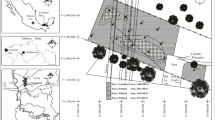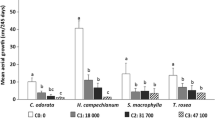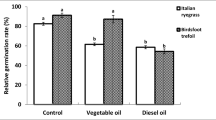Abstract
Oil spills from pipelines are a hazardous contamination source for agricultural soils. We investigated the effects of petroleum hydrocarbon (PHC) soil contamination, resulting from a real diesel oil pipeline spill, on the growth of Lupinus albus and Raphanus sativus plants. These species are widely cultivated for food purposes and have not been previously tested in soils affected by oil spills. Mesocosm-scale experiments were conducted in a greenhouse, and the potential transfer of hydrocarbons from soil to plant was evaluated. The results indicated that hydrocarbons in soil altered the soil nutrient balance and adversely affected plant growth. The C > 12 content in the aerial part was lower in plants grown in the contaminated soil than in plants grown in the control soil. The reduction in plant growth was not related to the accumulation of hydrocarbons in plant tissue, but rather to the deterioration in soil quality due to the oil spill.

Similar content being viewed by others
Availability of data and materials
All data generated and analysed during this study are included in the manuscript.
References
Balasubramaniyam A (2015) The influence of plants in the remediation of petroleum hydrocarbon-contaminated sites. Pharm Anal Chem Open Access 1:1–11. https://doi.org/10.4172/paco.1000105
Bellout Y, Khelif L, Guivarch A et al (2016) Impact of edaphic hydrocarbon pollution on the morphology and physiology of pea roots (Pisum sativum L.). Appl Ecol Environ Res 14:511–525. https://doi.org/10.15666/aeer/1402_511525
Chaineau CH, Morel JL, Oudot J (1997) Phytotoxicity and plant uptake of fuel oil hydrocarbons. J Environ Qual 26:1478–1483
Dennison T, Qin W, Loneman DM et al (2019) Genetic and environmental variation impact the cuticular hydrocarbon metabolome on the stigmatic surfaces of maize. BMC Plant Biol 19:1–16. https://doi.org/10.1186/s12870-019-2040-3
Devatha CP, Vishnu Vishal A, Purna Chandra Rao J (2019) Investigation of physical and chemical characteristics on soil due to crude oil contamination and its remediation. Appl Water Sci 9:3. https://doi.org/10.1007/s13201-019-0970-4
Diefendorf AF, Freeman KH, Wing SL, Graham HV (2011) Production of n-alkyl lipids in living plants and implications for the geologic past. Geochim Cosmochim Acta 75:7472–7485. https://doi.org/10.1016/j.gca.2011.09.028
EPA - United State Environmental Protection Agency (2014) Method 5021A Volatile organic compounds in various sample matrices using equilibrium headspace analysis. Duluth, MN, USA
EPA - United State Environmental Protection Agency (2007a) Method 3545A Pressurized fluid extraction (PFE). U.S. Environmental Protection Agency, Washington D.C.
EPA - United State Environmental Protection Agency (2017) Method 8270E Semivolatile organic compounds by gas chromatography/mass spectrometry. U.S. Environmental Protection Agency, Washington D.C.
EPA - United State Environmental Protection Agency (2007b) Method 8015 C, Nonhalogenated organics by gas chromatography. Washington D.C
EPA - United States Environmental Protection Agency (2017) Method 8260D Volatile organic compounds by gas chromatography/mass spectrometry. U.S. Environmental Protection Agency, Washington D.C.
Grifoni M, Rosellini I, Angelini P et al (2020) The effect of residual hydrocarbons in soil following oil spillages on the growth of Zea mays plants. Environ Pollut 265:114950. https://doi.org/10.1016/j.envpol.2020.114950
Hall J, Soole K, Bentham R (2011) Hydrocarbon phytoremediation in the family Fabaceae: a review. Int J Phytoremediat 13:317–332
Hawrot-Paw M, Bąkowska T (2014) Growth and development of selected plant species in the phytoremediation of diesel oil contaminated soil. Environ Prot Eng 40:5–13. https://doi.org/10.5277/epe140401
Hunt LJ, Duca D, Dan T, Knopper LD (2019) Petroleum hydrocarbon (PHC) uptake in plants: a literature review. Environ Pollut 245:472–484. https://doi.org/10.1016/J.ENVPOL.2018.11.012
ISO - International Organization for Standardization (2004) ISO 16703:2004 - Soil quality - Determination of content of hydrocarbon in the range C10 to C40 by gas chromatography
Kaur N, Erickson TE, Ball AS, Ryan MH (2017) A review of germination and early growth as a proxy for plant fitness under petrogenic contamination—knowledge gaps and recommendations. Sci Total Environ 603–604:728–744
Khan MAI, Biswas B, Smith E et al (2018) Toxicity assessment of fresh and weathered petroleum hydrocarbons in contaminated soil: a review. Chemosphere. https://doi.org/10.1016/J.CHEMOSPHERE.2018.08.094
Khan S, Farooq R, Shahbaz S et al (2009) Health risk assessment of heavy metals for population via consumption of vegetables. World Appl Sci J 6:1602–1606
Koshlaf E, Ball S A (2017) Soil bioremediation approaches for petroleum hydrocarbon polluted environments. AIMS Microbiol 3:25–49. https://doi.org/10.3934/microbiol.2017.1.25
Lassalle G, Fabre S, Credoz A et al (2020) Monitoring oil contamination in vegetated areas with optical remote sensing: a comprehensive review. J Hazard Mater 393:122427
Legislative Decree 152/2006 (2006) Rules in environmental field. Italian Official Journal
Liang Y, Zhang X, Wang J, Li G (2012) Spatial variations of hydrocarbon contamination and soil properties in oil exploring fields across China. J Hazard Mater 241–242:371–378. https://doi.org/10.1016/j.jhazmat.2012.09.055
Liao C, Xu W, Lu G et al (2015) Accumulation of hydrocarbons by maize (Zea mays L.) in remediation of soils contaminated with crude oil. Int J Phytoremediat 17:693–700. https://doi.org/10.1080/15226514.2014.964840
Merkl N, Schultze-Kraft R, Infante C (2004) Phytoremediation in the tropics-the effect of crude oil on the growth of tropical plants. Bioremediat J 8:177–184. https://doi.org/10.1080/10889860490887527
Ossai IC, Ahmed A, Hassan A, Hamid FS (2020) Remediation of soil and water contaminated with petroleum hydrocarbon: a review. Environ Technol Innov 17:100526
Paris A, Ledauphin J, Poinot P, Gaillard JL (2018) Polycyclic aromatic hydrocarbons in fruits and vegetables: origin, analysis, and occurrence. Environ Pollut 234:96–106
Patowary R, Patowary K, Devi A et al (2017) Uptake of total petroleum hydrocarbon (TPH) and polycyclic aromatic hydrocarbons (PAHs) by Oryza sativa L. grown in soil contaminated with crude oil. Bull Environ Contam Toxicol 98:120–126. https://doi.org/10.1007/s00128-016-1990-5
Peralta-Videa JR, Lopez ML, Narayan M et al (2009) The biochemistry of environmental heavy metal uptake by plants: implications for the food chain. Int J Biochem Cell Biol 41:1665–1677. https://doi.org/10.1016/j.biocel.2009.03.005
Petruzzelli G, Pedron F, Rosellini I et al (2016) Polycyclic aromatic hydrocarbons and heavy metal contaminated sites: phytoremediation as a strategy for addressing the complexity of pollution. In: Ansari AA, Sarvajeet Singh G, Ritu G (eds) Phytoremediation. Springer, Berlin, pp 61–90
Pullagurala VLR, Rawat S, Adisa IO et al (2018) Plant uptake and translocation of contaminants of emerging concern in soil. Sci Total Environ 636:1585–1596
Riskuwa-Shehu ML, Ijah UJJ, Manga SB, Bilbis LS (2017) Evaluation of the use of legumes for biodegradation of petroleum hydrocarbons in soil. Int J Environ Sci Technol 14:2205–2214. https://doi.org/10.1007/s13762-017-1303-5
Smith MJ, Flowers TH, Duncan HJ, Alder J (2006) Effects of polycyclic aromatic hydrocarbons on germination and subsequent growth of grasses and legumes in freshly contaminated soil and soil with aged PAHs residues. Environ Pollut 141:519–525. https://doi.org/10.1016/j.envpol.2005.08.061
Sparks DL, Page AL, Helmke PA, Loeppert RH (1996) Methods of soil analysis Part 3—chemical methods. Soil Science Ssociety of American, Madison
Wang X, Feng J, Zhao J (2010) Effects of crude oil residuals on soil chemical properties in oil sites, Momoge Wetland, China. Environ Monit Assess 161:271–280. https://doi.org/10.1007/s10661-008-0744-1
Wang Z, Yang C, Yang Z et al (2012) Fingerprinting of petroleum hydrocarbons (PHC) and other biogenic organic compounds (BOC) in oil-contaminated and background soil samples. J Environ Monit 14:2367–2381. https://doi.org/10.1039/c2em30339f
Acknowledgements
The Authors would like to thank Manuele Scatena, IRET-CNR, for his technical assistance, and Dr. Gabriele Cerutti, HPC Italia S.R.L., for his technical support in the field activities.
Funding
This work was supported by ENI Refining&Marketing Eni S.p.A.
Author information
Authors and Affiliations
Contributions
Formal analysis: MG, IR; Investigation: MG, IR; Writing - Original draft preparation: MG, GP, BP; Writing - Review & Editing: MG, GP, BP; Supervision: MG, GP, BP; Visualization: MG; Conceptualization: PA, GP, BP; Resources: PA; Funding acquisition: PA; Methodology: GP, BP; Project administration: GP, BP; Validation: MG, GP, BP.
Corresponding author
Ethics declarations
Conflict of interest
The authors have no conflicts of interest to declare that are relevant to the content of this article.
Additional information
Publisher’s Note
Springer Nature remains neutral with regard to jurisdictional claims in published maps and institutional affiliations.
Rights and permissions
About this article
Cite this article
Martina, G., Irene, R., Paolo, A. et al. A Preliminary Study on Lupinus albus and Raphanus sativus Grown in Soil Affected by Oil Spillage. Bull Environ Contam Toxicol 107, 917–923 (2021). https://doi.org/10.1007/s00128-021-03290-9
Received:
Accepted:
Published:
Issue Date:
DOI: https://doi.org/10.1007/s00128-021-03290-9




